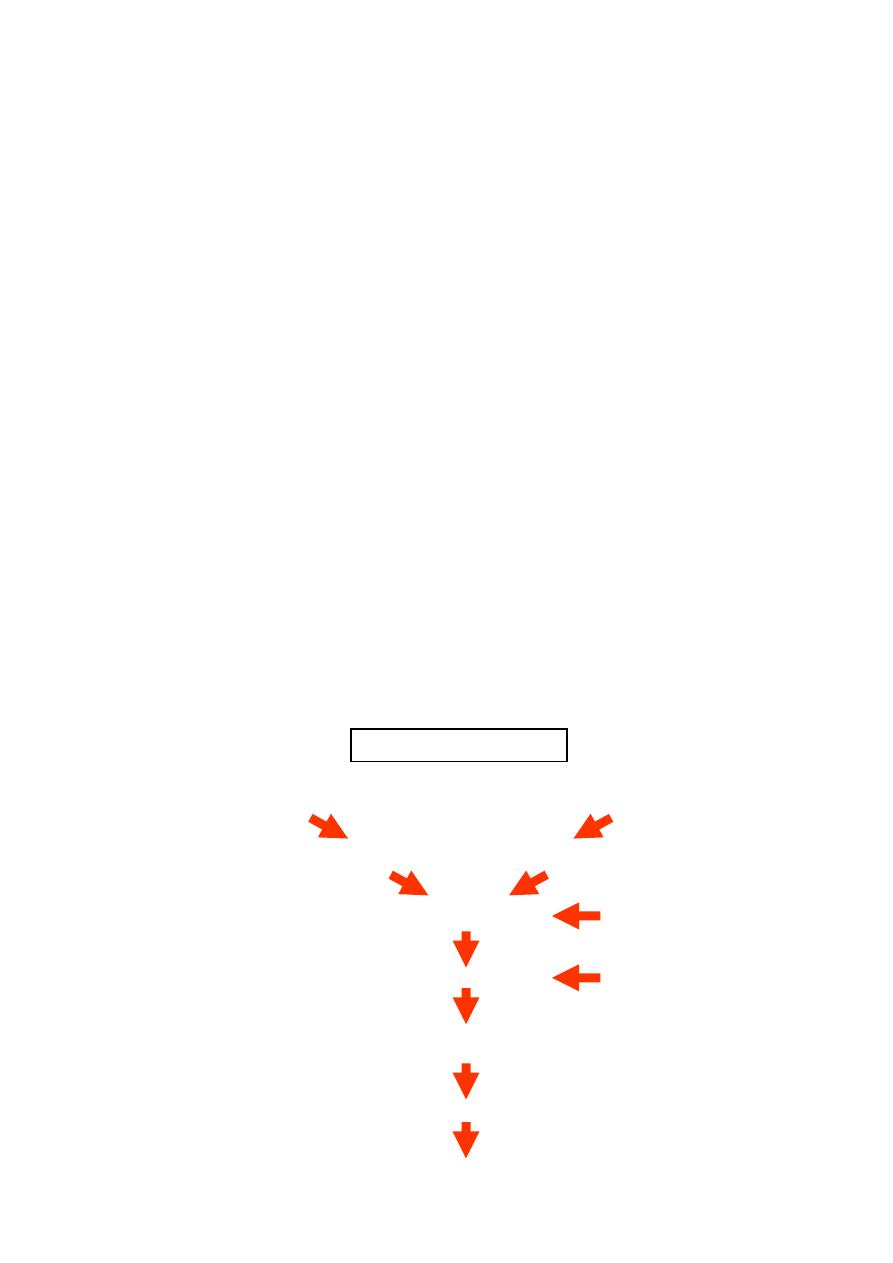
1
VENTRICULAR SYSTEM
-
The ventricles are four fluid-filled cavities located within the brain
-
These are the two lateral ventricles, the third ventricle, and the fourth
ventricle
-
The two lateral ventricles communicate through the interventricular
foramina with the third ventricle .
-
The third ventricle is connected to the fourth ventricle by the narrow
cerebral aqueduct
-
The fourth ventricle, in turn, is continuous with the narrow central canal
of the spinal cord and, through the three foramina in its roof, with the
subarachnoid s pace.
-
The central canal in the spinal cord has a small dilatation at its infe rior
end, referred to as the terminal ventricle
-
The ventricles are lined throughout with ependyma and are filled with
cerebros pinal fluid
-
They are developmentally derived from the cavity of the neural tube.
The Lateral Ventricles:
-
There are two large lateral ventricles, one is present in each cerebral
hemisphere nearer to the base than the top of the brain
-
The ventricle is a roughly C-shaped cavity and may be divided into a
body, which occupies the parietal lobe and from which ante rior,
posterior, and inferior horns extend into the frontal, occipital, and
temporal lobes, respectively.
-
They are separated from each other by a median vertical partition, the
septum pellucidum, but communicate with the third ventricle and
indirectly with each othe r through the interventricular foramen which
lies in the anterior part of the medial wall of the ventricle
-
The foramen is bounded anteriorly by the anterior column of the fornix
and posteriorly by the anterior end of the thalamus
The body (central part):
-
Extends from the interventricular foramen posteriorly as far as the
posterior end of the thalamus whe re it becomes continuous with the
posterior and the inferior horns.
-
The roof is forme d by the undersurface of the corpus callos um
-
The floor is formed by the body of the caudate nucle us and the lateral
margin of the thalamus, the superior surface of the thalamus is obscured
in its medial part by the body of the fornix.
-
The choroid plexus of the ventricle projects into the body of the ventricle
through the slit-like gap between the body of the fornix and the superior
surface of the thalamus which is known as the choroidal fissure
-
Through this fissure, the blood vessels of the plexus invaginate the pia
mater of the tela choroidea and the ependyma of the lateral ventricle.
-
The medial wall is formed by the septum pellucidum
The anterior horn:
-
Extends forward into the frontal lobe
-
It is continuous posteriorly with the body of the ventricle at the
interventricular foramen.
-
The roof is forme d by the undersurface of the ante rior part of the corpus
callosum, the genu which limits the ante rior horn ante riorly

2
-
The floor is formed by the rounded head of the caudate nucleus medially,
a small portion is forme d by the superior surface of the rostrum of the
corpus callosum .
-
The medial wall is formed by the septum pellucidum and the anterior
column of the fornix
The posterior horn:
-
Extends posteriorly into the occipital lobe
-
The roof and lateral wall are formed by the fibers of the tapetum of the
corpus callosum.
-
Lateral to the tapetum are the fibers of the optic radiation
-
The medial wall of the posterior horn has two elevations:
1- The superior s welling (bulb of posterior horn): is produced by the splenial
fibers of the corpus callosum (forceps major) passing posteriorly into the
occipital lobe.
2- The inferior s welling (calcar avis): is produced by the calcarine sulcus.
The infe rior horn:
-
Extends ante riorly into the temporal lobe
-
The roof is forme d by the inferior surface of the tapetum of the corpus
callosum and by the tail of the caudate nucleus which passes anteriorly to
end in the amygdaloid nucleus.
-
Medial to the tail of the caudate nucleus is the stria terminalis, which also
ends ante riorly in the amygdaloid nucleus
-
The floor is formed laterally by the collateral e minence, produced by the
collate ral fissure, and me dially by the hippocampus
-
The anterior end of the hippocampus is expanded and slightly furrowed
to form the pes hippocampus.
-
The hippocampus is composed of gray matter; however, the ventricular
surface of the hippocampus is covered by a thin layer of white matter
called the alveus, which is formed from the axons of the cells of the
hippocampus.
-
These axons converge on the medial border of the hippocampus to form a
bundle known as the fimbria.
-
The fimbria of the hippocampus becomes continuous posteriorly with the
posterior column of the fornix.
Choroid plexus of the lateral ventricle:
-
The choroid plexus is, in fact, the irregular lateral edge of the tela
choroidea, which is a two-layered fold of pia mater situated between the
fornix superiorly and the upper surface of the thalamus
-
Projects into the ventricle on its medial aspect and is a vascular fringe
composed of pia mater covered with the ependymal lining of the
ventricular cavity
-
At the junction of the body of the lateral ventricle and the inferior horn,
the choroid plexus is continued into the infe rior horn and projects
through the choroidal fissure
-
The function of the choroid plexus is to produce cerebrospinal fluid
The third ventricle:
-
The third ventricle is a median cleft between the two thalami.
-
Behind, it communicates with the fourth ventricle through the cerebral
aqueduct, and in front with the late ral ventricles through the
interventricular foramen.

3
-
Some what triangular in shape, with the apex directed backward, it has a
roof, a floor, an ante rior and a posterior boundary and a pair of late ral
walls.
The roof:
-
Is formed by a layer of epithelium, which stretches between the upper
edges of the lateral walls of the cavity and is continuous with the epithelial
lining of the ventricle
-
It is covered by and adherent to a fold of pia mater, name d the tela
choroidea of the third ventricle
-
From the under s urface of which a pair of vascular fringed processes, one
on each side of the midline, the choroid plexuses of the third ventricle
hang
The floor:
-
Slopes downward and forward and is forme d mainly by the structures
which constitute the hypothalamus
-
From before backward these are: the optic chias ma, the tuber cinereum,
infundibulum, and the corpora mammillaria
-
The ventricle is prolonged downward as a funnel-shaped recess, the
recessus infundibuli, into the infundibulum to the apex of which the
hypophysis is attached
The anterior wall:
-
Constituted below by the lamina terminalis, a thin layer of gray substance
stretching from the uppe r surface of the optic chias ma to the rostrum of
the corpus callosum; above by the columns of the fornix and the ante rior
commissure
-
At the junction of the floor and anterior wall, imme diately above the optic
chias ma, the ventricle presents a small angular recess or diverticulum, the
optic recess
-
At the junction of the roof and ante rior wall of the ventricle, and situated
between the thalami behind and the columns of the fornix in front, is the
interventricular foramen through which the third communicates with the
lateral ventricles
The posterior wall:
-
Formed by the pineal body, the posterior commissure and the cerebral
aqueduct.
-
A small recess, the pineal recess, projects into the stalk of the pineal body,
while in front of and above the pineal body is a second recess, the
suprapineal recess
The lateral wall:
-
Consists of an upper portion forme d by the medial surface of the anterior
two-thirds of the thalamus, and a lowe r consisting of an upward
continuation of the gray substance of the ventricular floor, the 2 are
separated by the hypothalamic sulcus
-
The lateral walls are joined to each othe r across the cavity of the ventricle
by a band of gray matter, the massa interme dia or interthalamic adhesion
Cerebral Aqueduct:
-
The cerebral aqueduct is a narrow channel about ¾ of an inch (1.8 cm)
long
-
It connects the third ventricle with the fourth ventricle

4
-
It is lined with ependyma and is surrounded by a laye r of gray matter
called the central gray.
-
The direction of flow of cerebros pinal fluid is from the third to the fourth
ventricle.
-
There is no choroid plexus in the cerebral aqueduct.
The fourth ventricle:
-
Is a tent-shaped cavity filled with CSF
-
It is situated anterior to the cerebellum and posterior to the pons and the
superior half of the medulla oblongata
-
It is lined with ependyma and is continuous above with the cerebral
aqueduct of the midbrain and below with the central canal of the me dulla
oblongata and the spinal cord
-
The fourth ventricle possesses lateral boundaries, a roof, and a rhomboid-
shaped floor.
Lateral Boundaries:
-
Cephalic part: superior cerebellar peduncle
-
Caudal part: inferior cerebellar peduncle
The roof (posterior wall):
-
The tent-shaped roof projects into the cerebellum
-
The superior part is formed by the medial borders of the two superior
cerebellar peduncles and a connecting sheet of white matter called the
superior medullary velum
-
The infe rior part of the roof is formed by the inferior medullary velum,
which consists of a thin sheet devoid of nervous tissue and forme d by the
ventricular ependyma and its posterior covering of pia mater
-
This part of the roof (inferior) is pierced in the midline by a large
aperture, the median aperture or foramen of Magendie
-
Lateral recesses extend laterally around the sides of the medulla and open
anteriorly as the lateral openings of the fourth ventricle, or the foramina
of Luschka
-
Thus, the cavity of the fourth ventricle communicates with the
subarachnoid s pace through these three openings
-
These important openings provide the only exit which permits the
cerebros pinal fluid to flow from the ventricular system into the
subarachnoid s pace
-
From the subarachnoid space CSF is absorbed continuo usly in the
arachnoid villi & granulations in the superior sagittal sinus
The floor (rhomboid fossa):
-
The diamond-shaped floor is formed by the posterior s urface of the pons
and the cranial half of the medulla oblongata
-
It is covered by a thin layer of gray substance continuous with that of the
medulla spinalis; superficial to this is a thin lamina of neuroglia which
constitutes the ependyma of the ventricle and supports a layer of ciliated
epithelium
- The floor is divided into symmetrical halves by the median sulcus
-
On each side of this sulcus, the re is an elevation, the medial e minence,
which is bounded laterally by another s ulcus, the sulcus limitans.
-
Lateral to the sulcus limitans, there is the vestibular area beneath which
the vestibular nuclei lie

5
-
The facial colliculus is a slight s welling at the inferior end of the medial
eminence that is produced by the fibers from the motor nucleus of the
facial nerve looping over the abducens nucleus
-
At the superior end of the sulcus limitans, there is a bluish-gray area,
produced by a cluster of ne rve cells containing melanin pigment; the
substantia ferruginea
-
Strands of nerve fibers, the stria medullaris, de rived from the arcuate
nuclei, eme rge from the median s ulcus and pass laterally ove r the medial
eminence and the vestibular area and enter the inferior cerebellar
peduncle to reach the cerebellum
-
Infe rior to the stria medullaris, the following features should be
recognized in the floor of the ventricle:
-
The most medial is the hypoglossal triangle, which indicates the position
of the unde rlying hypoglossal nucleus
-
Lateral to this is the vagal triangle, beneath which lies the dorsal motor
nucleus of the vagus
-
The area postre ma is a narrow area between the vagal triangle and the
lateral margin of the ventricle, just rostral to the opening into the central
canal
-
The infe rior part of the vestibular area also lies lateral to the vagal
triangle
Choroid plexus & tela choroidea:
-
The choroid plexus of the fourth ventricle is T shape
- It is suspended from the inferior half of the roof of the ventricle and is
forme d from the highly vascular tela choroidea.
-
The tela choroidea is a two-layered fold of pia mater that projects
through the roof of the ventricle and is covered by ependyma.
-
The blood supply to the plexus is from the posterior infe rior cerebellar
arte ries
Choroid plexus of the
lateral ventricles
Choroid plexus of
the 3
rd
ventricle
Choroid plexus of the
lateral ventricles
The lateral ventricles
The lateral ventricles
The 3
rd
ventricle
Choroid plexus of
the 4
th
ventricle
The 4
th
ventricle
Cisterna
cerbellome dullaris
Other cisterns & SAS
Superior sagittal sinus
Interventricular foramen
Cerebral aqueduct
1 median & 2 lateral apertures of
the 4
th
ventricle
Arachnoid villi & granulations
CSF circulation

6
THE LIMBIC SYSTEM
-
The word limbic means borde r or margin, and the term limbic system
was loosely used to include a group of structures that lie in the border
zone between the cerebral cortex and the hypothalamus.
-
Now it is recognized, as the result of research, that the limbic system is
involved with many other structures beyond the border zone in the
control of e motion, behavior, and drive; it also appears to be important to
me mory.
-
Anatomically, the limbic structures include:
1- The subcallosal, the cingulate, and the parahippocampal gyri
2- The hippocampal formation
3- The amygdaloid nucleus
4- The mammillary bodies
5- The anterior thalamic nucleus
6- The olfactory lobe which consists of; O. bulb, tract, trigone & anterior
perforated substance
-
The alveus, the fimbria, the fornix, the mammillothalamic tract, and the
stria te rminalis constitute the connecting pathways of this system.
Hippocampal Formation:
-
The hippocampal formation consists of the hippocampus, the dentate
gyrus, and the parahippocampal gyrus.
-
The hippocampus is a curved elevation of gray matter that extends
throughout the entire length of the floor of the infe rior horn of the lateral
ventricle
-
Its anterior end is expanded to form the pes hippocampus.
-
It is named hippocampus because it resembles a sea horse in coronal
section.
-
The convex ventricular surface is covered with ependyma, beneath which
lies a thin layer of white matter called the alveus
-
The alveus consists of nerve fibers that have originated in the
hippocampus, and these converge medially to form a bundle called the
fimbria
-
The fimbria, in turn, becomes continuous with the crus of the fornix
-
The hippocampus terminates posteriorly beneath the splenium of the
corpus callosum.
The dentate gyrus:
-
A narrow, notche d band of gray matter that lies between the fimbria of
the hippocampus and the parahippocampal gyrus
-
Posteriorly, the gyrus accompanies the fimbria almost to the splenium of
the corpus callosum and becomes continuous with the indusium griseum .
The indusium griseum:
- A thin, vestigial layer of gray matter that covers the supe rior surface of the
corpus callosum
-
Embedded in the superior surface of the indusium griseum are two
slender bundles of white fibers on each side called the medial and lateral
longitudinal striae.
-
The striae are the remains of the white matter of the vestigial indusium
griseum.
-
Anteriorly, the dentate gyrus is continued into the uncus.
The parahippocampal gyrus:

7
-
Lies between the hippocampal fissure and the collateral sulcus
-
It is continuous with the hippocampus along the medial edge of the
temporal lobe
Amygdaloid Nucleus:
-
The amygdaloid nucleus is so name d because it resembles an almond.
-
It is situated partly anterior and partly superior to the tip of the infe rior
horn of the late ral ventricle
-
It is fused with the tip of the tail of the caudate nucleus, which has passed
anteriorly in the roof of the inferior horn of the lateral ventricle.
-
The stria terminalis emerges from its posterior aspect.
-
Mamillary bodies (hypothalamus)
-
Anterior thalamic nuclei (thalamus)
Connecting Pathways of the Limbic System:
- The alveus consists of a thin layer of white matte r that lies on the superior or
ventricular s urface of the hippocampus, it is composed of nerve fibers that
originate in the hippocampal cortex.
- The fimbria is the fibe rs of the alveus after they conve rge on the medial surface
of the hippocampus
-
The fimbria now leaves the posterior end of the hippocampus as the crus
of the fornix which from each side curves posteriorly and superiorly
beneath the splenium of the corpus callosum and around the posterior
surface of the thalamus.
-
The two crura now conve rge to form the body of the fornix, which is
applied closely to the unde rsurface of the corpus callos um
-
As the two crura come togethe r, they are connected by transverse fibers
called the commissure of the fornix
-
These fibers decussate and join the hippocampi of the two sides.
-
Anteriorly, the body of the fornix is connected to the unders urface of the
corpus callosum by the septum pellucidum.
-
Infe riorly, the body of the fornix is related to the tela choroidea and the
ependymal roof of the third ventricle.
-
The body of the fornix splits anteriorly into two anterior columns of the
fornix, each of which curves anteriorly and inferiorly over the
interventricular foramen, then, each column disappears into the lateral
wall of the third ventricle to reach the mammillary body
-
The mammillothalamic tract provides important connections between the
mammillary body and the anterior nuclear group of the thalamus.
-
The stria terminalis emerges from the posterior aspect of the amygdaloid
nucleus and runs as a bundle of nerve fibers posteriorly in the roof of the
inferior horn of the lateral ve ntricle on the medial side of the tail of the
caudate nucleus. It follows the curve of the caudate nucle us and comes to
lie in the floor of the body of the lateral ventricle.
Afferent Connections of the Hippocampus:
1. Fibers from the cingulate gyrus
2. Fibers from the septal nuclei (nuclei lying within the midline close to the
anterior commissure) pass posterior in the fornix to the hippocampus .
3. Fibers from one hippocampus pass across the midline to the opposite
hippocampus in the commissure of the fornix.
4. Fibers from the indusium griseum pass posteriorly in the longitudinal
striae

8
5. Fibers from the entorhinal area or olfactory-associated cortex
6. Fibers from the dentate and parahipp. gyri
Effe rent Connections of the Hippocampus:
1. Fibers pass posterior to the anterior commissure to enter the mammillary
body.
2. Fibers pass posterior to the anterior commissure to end in the anterior
nuclei of the thalamus.
3. Fibers pass posterior to the anterior commissure to enter the tegmentum
of the midbrain.
4. Fibers pass anterior to the anterior commissure to end in the septal
nuclei, the lateral preoptic area, and the anterior part of the
hypothalamus.
5. Fibers join the stria medullaris thalami to reach the habenular nuclei.
6. The limbic system not only are interconnected but also send projection
fibers to many different parts of the ne rvous system
7. Physiologists now recognize the importance of the hypothalamus as being
the major output pathway of the limbic system
Functions of the Limbic System:
1- The limbic system, via the hypothalamus and its connectio ns with the outflow
of the autonomic nervous system and its control of the endocrine system, is able
to influence many aspects of emotional behavior. These include particularly the
reactions of fear and anger and the emotions associated with sexual behavio r.
2- There is also evidence that the hippocampus is concerned with converting
recent memory to long-term me mory. A lesion of the hippocampus results in the
individual being unable to store long-term memory. Memory of remote past
events before the lesion developed is unaffected(ante rograde amnesia).
3- There is no evidence that the limbic system has an olfactory function. The
various affe rent and efferent connections of the limbic system provide pathways
for the integration and effective homeostatic respons es to a wide variety of
environme ntal stimuli.
THE VISUAL PATHWAY
-
Axons of the retinal ganglionic cell layrer converge on the optic disc and
exit from the eye, about 3 or 4 mm to the nasal side of its center, as the
optic nerve
-
The optic ne rve leaves the orbital cavity through the optic canal and
unites with the optic nerve of the opposite side to form the optic chiasma.
-
The optic chias ma is situated at the junction of the anterior wall and floor
of the third ventricle.
-
In the chiasma, the fibers from the nasal (medial) half of each retina,
including the nasal half of the macula cross the midline and enter the
optic tract of the opposite side, while the fibe rs from the temporal
(lateral) half of each retina, including the temporal half of the macula,
pass posteriorly in the optic tract of the same side.
-
The optic tract e merges from the optic chiasma and passes
posterolate rally around the cerebral peduncle.
-
Most of the fibers now terminate by synapsing with ne rve cells in the
lateral geniculate body, which is a small projection from the posterior
part of the thalamus. A fe w of the fibers pass to the pretectal nucleus and
the supe rior colliculus of the midbrain and are concerned with light
reflexes

9
-
Lateral geniculate body is a small, oval s welling projecting f rom the
pulvinar of the thalamus. It consists of six layers of cells, on which
synapse the axons of the optic tract. The axons of the nerve cells within
the geniculate body leave it to form the optic radiation
-
The optic radiation passes posteriorly through the retrolenticular part of
the internal capsule and te rminates in the visual cortex (area 17), which
occupies the upper and lowe r lips of the calcarine sulcus on the medial
surface of the cerebral he misphere
-
The visual association cortex (areas 18 and 19) is responsible for
recognition of objects and pe rception of color
Visual Reflexes:
Direct and Consensual light reflexes:
-
If a light is shone into one eye, the pupils of both eyes normally constrict.
-
The constriction of the pupil on which the light is s hone is called the
direct light reflex ;the constriction of the opposite pupil, even though no
light fell on that eye, is called the consensual light reflex
-
The afferent impulses travel through the optic nerve, optic chias ma, and
optic tract
-
Here, a small number of fibers leave the optic tract and synapse on nerve
cells in the pretectal nucleus ,which lies close to the superior colliculus.
-
The impulses are passed by axons of the pretectal nerve cells to the
parasympathetic nuclei (Edinger-Westphal nuclei) of the third cranial
nerve on both sides .
-
Here, the fibers synapse and the parasympathetic ne rves travel through
the third cranial nerve to the ciliary ganglion in the orbit
-
Finally, postganglionic parasympathetic fibers pass through the short
ciliary ne rves to the eyeball and the constrictor pupillae muscle of the iris.
-
Both pupils constrict in the consensual light reflex because the pretectal
nucleus sends fibers to the parasympathetic nuclei on both sides of the
midbrain
-
The fibe rs that cross the median plane do so close to the cerebral
aqueduct in the posterior commissure.
Accommodation reflex:
-
When the eyes are directed from a distant to a near object, contraction of
the medial recti brings about conve rgence of the ocular axes; the lens
thickens to increase its refractive powe r by contraction of the ciliary
muscle; and the pupils constrict to restrict the light waves to the thickest
central part of the lens.
-
The afferent impulses travel through the optic nerve, the optic chiasma,
the optic tract, the lateral geniculate body, and the optic radiation to the
visual cortex.
-
The visual cortex is connected to the eye field of the frontal cortex
-
From here, cortical fibers descend through the internal capsule to the
oculomotor nuclei in the midbrain.
-
The oculomotor nerve travels to the medial recti muscles.
-
Some of the descending cortical fibers synapse with the parasympathetic
nuclei (Edinger-Westphal nuclei) of the third cranial nerve on both sides .
-
Here, the fibers synapse, and the parasympathetic ne rve s travel through
the third cranial nerve to the ciliary ganglion in the orbit.

10
-
Finally, postganglionic parasympathetic fibers pass through the short
ciliary ne rves to the ciliary muscle and the constrictor pupillae muscle of
the iris
Corneal reflex:
-
Light touching of the cornea or conjunctiva results in blinking of the
eyelids.
-
Afferent impulses from the cornea or conjunctiva travel through the
ophthalmic division of the trige minal ne rve to the sensory nucleus of the
trigeminal nerve
-
Inte rnuncial neurons connect with the motor nucleus of the facial nerve
on both sides through the medial longitudinal fasciculus.
-
The facial nerve and its branches supply the orbicularis oculi muscle,
which causes closure of the eyelids.
Visual body reflexes:
-
The automatic scanning movements of the eyes and head that are made
when reading, the automatic move ment of the eyes, head, and neck
toward the source of the visual stimulus, and the protective closing of the
eyes and even the raising of the arm for protection are reflex actions that
involve the following reflex arcs
-
The visual impulses follow the optic nerves, optic chias ma, and optic
tracts to the superior colliculi.
-
Here, the impulses are relayed to the tectospinal and tectobulbar
(tectonuclear) tracts and to the neuro ns of the anterior gray columns of
the spinal cord and cranial motor nuclei.
Pupillary skin reflex:
-
The pupil will dilate if the skin is painfully stimulated by pinching.
-
The afferent sensory fibers are believed to have connections with the
efferent preganglionic sympathetic neurons in the lateral gray columns of
the first and second thoracic segments of the spinal cord.
-
The white rami communicantes of these segments pass to the sympathetic
trunk, and the preganglionic fibe rs ascend to the superior cervical
sympathetic ganglion .
-
The postganglionic fibers pass through the internal carotid plexus and the
long ciliary nerves to the dilator pupillae muscle of the iris.
CEREBRAL CORTEX
General appearance of the cerebral hemispheres:
-
The cerebral he misphe res are the largest part of the brain; they are
separated by a deep midline sagittal fissure, the longitudinal cerebral
fissure
-
The fissure contains the sickle-shaped fold of dura mater, the falx cerebri,
and the ante rior cerebral arte ries.
-
In the depths of the fissure, the great commissure, the corpus callosum,
connects the hemispheres across the midline
-
A second horizontal fold of dura mater separates the cerebral
hemispheres from the cerebellum and is called the tentorium ce rebelli.
-
To increase the surface area of the cerebral cortex, the surface is thrown
into folds (gyri), which are separated from each other by fissures (sulci)
-
For descriptive purposes, each hemisphere is divided into lobes, which are
named according to the cranial bones unde r which they lie

11
-
The central and parieto-occipital sulci and the lateral and calcarine sulci
are boundaries used for the division of the cerebral he mis phe re into
frontal, parietal, temporal, and occipital lobes
Surfaces of the he mispheres:
1-The lateral s urface; is convex in adaptation to the concavity of the
corresponding half of the vault of the cranium
2- The medial surface; is flat and vertical, and is separated from that of the
opposite hemisphere by the great longitudinal fissure and the falx cerebri
3- The inferior s urface; is of an irregular form, and may be divided into three
areas:
-
The anterior area, forme d by the orbital surface of the frontal lobe, is
concave, and rests on the roof of the orbit and nose
-
The middle area is convex, and consists of the under surface of the
temporal lobe: it is adapted to the corresponding half of the middle
cranial fossa
-
The posterior area is concave, directed medialward as well as downward,
and is name d the tentorial surface
Main Sulci:
The central sulcus:
-
Is of great importance because since it separates the two major cortical
areas (sensory & motor)
-
The central sulcus indents the superior me dial border of the he misphe re
about 1 cm be hind the midpoint
-
It runs downward and forward across the lateral aspect of the
hemisphere, and its lower end is separated from the posterior ramus of
the lateral sulcus by a narrow bridge of cortex.
-
The central sulcus is the only sulcus of any length on this surface of the
hemisphere that indents the superomedial border and lies between two
parallel gyri.
The lateral sulcus:
-
Is a deep cleft found mainly on the inferior and lateral surfaces of the
cerebral hemisphere.
-
It consists of a short stem that divides into three rami.
-
The stem arises on the inferior surface, and on reaching the lateral
surface, it divides into the anterior, ascending and continues as the
posterior ramus
-
An area of cortex called the ins ula lies at the bottom of the deep lateral
sulcus and cannot be seen from the surface unless the lips of the sulcus
are separated
The parieto-occipital sulcus:
-
Begins on the superior me dial margin of the hemisphere about 5 cm
anterior to the occipital pole
-
It passes downward and anteriorly on the medial surface to meet the
calcarine sulcus
The calcarine sulcus:
-
Is found on the medial surface of the he misphere
-
It commences unde r the posterior end of the corpus callosum and arches
upward and backward to reach the occipital pole, whe re it stops.

12
-
In some brains, however, it continues for a short distance onto the late ral
surface of the he misphere.
-
The calcarine sulcus is joined at an acute angle by the parieto-occipital
sulcus about halfway along its length
Lobes & gyri of the cerebrum:
Superolateral Surface of the Hemisphere:
-
The frontal lobe occupies the area anterior to the central sulcus and
superior to the lateral sulcus
-
The superolateral s urface of the frontal lobe is divided by three sulci into
four gyri.
-
The precentral sulcus runs parallel to the central sulcus, and the
precentral gyrus lies between them
-
Extending anteriorly from the precentral sulcus are the supe rior and
inferior frontal sulci
-
These two sulci divide the re maining part of this lobe into superior,
middle & inferior frontal gyri
-
The infe rior frontal gyrus is invaded by the anterior and ascending rami
of the lateral sulcus between the m lie the pars triangularis.
-
The parietal lobe occupies the area posterior to the central sulcus and
superior to the lateral sulcus
-
It extends posteriorly as far as the parieto-occipital sulcus
-
The lateral surface of the parietal lobe is div ided by two sulci into three
gyri.
-
The postcentral sulcus runs parallel to the central sulcus, and the
postcentral gyrus lies between the m.
-
Running posteriorly from the middle of the postcentral sulcus is the
intraparietal sulcus which divides the reminder of the lobe into superior
& inferiorparietal lobules
-
The temporal lobe occupies the area infe rior to the lateral sulcus
-
The lateral surface of the temporal lobe is divided into three gyri by two
sulci.
-
The superior and middle temporal sulci run parallel to the posterior
ramus of the lateral sulcus and divide the temporal lobe into the superior,
middle, and inferior temporal gyri, the latter is continued onto the
inferior s urface of the hemisphere
Medial and inferior surfaces of the hemisphere:
-
There are many important areas that should be recognized:
-
The corpus callosum, which is the largest commissure of the brain, forms
a striking feature on this surface
-
The cingulate gyrus begins beneath the anterior end of the corpus
callosum and continues above it posteriorly
-
The gyrus is separated from the corpus callosum by the callosal sulcus &
from the superior frontal gyrus by the cingulate sulcus
-
The paracentral lobule is the area of the cerebral cortex that surrounds
the indentation produced by the central sulcus on the superior border
-
The anterior part of this lobule is a continuation of the precentral gyrus
on the superior lateral s urface, & the posterior part is a continuation of
the postcentral gyrus.
-
The precuneus: is an area of cortex bounded anteriorly by the posterior
end of the cingulate & by the parieto-occipital s ulci.

13
-
The cuneus: is a triangular area of cortex bounded above by the parieto-
occipital sulcus, infe riorly by the calcarine sulcus
-
The collateral sulcus is situated on the infe rior surface of the hemis phe re
& runs anteriorly below the calcarine sulcus.
-
Between the collate ral sulcus and the calcarine sulcus is the lingual gyrus.
-
Anterior to the lingual gyrus is the parahippocampal gyrus which
terminates in front as the hooklike uncus.
-
The medial occipitotemporal gyrus extends from the occipital pole to the
temporal pole, it is bounded medially by the collateral and rhinal sulci
and laterally by the occipitotemporal sulcus.
-
The occipitote mporal gyrus lies lateral to the sulcus and is continuous
with the inferior te mporal gyrus
-
On the infe rior surface of the frontal lobe, the olfactory bulb and tract
overlie the olfactory sulcus
-
Medial to the olfactory sulcus is the gyrus rectus & lateral to it are a
number of orbital gyri
Structure of the cerebral cortex:
-
The cerebral cortex forms a complete covering of the cerebral
hemisphere.
-
It is composed of gray matter and has been estimated to contain
approximately 10 billion neurons.
-
Some neurones synapse with more than ten thousand neurones, so the
estimated number of synapses in the cerebral cortex is 60 trillion
-
The thickness of the cortex varies from 1.5 to 4.5 mm. being thickest over
the crest of a gyrus and thinnest in the depth of a sulcus.
-
The cerebral cortex, like gray matter elsewhere in the ce ntral nervous
system, consists of a mixture of nerve cells, nerve fibers, neuroglia, and
blood vessels.
-
The following types of nerve cells are present in the cerebral cortex:
(1) pyramidal cells, (2) stellate cells, (3) fusiform cells, (4) horizontal cells of
Cajal, and (5) cells of Martinotti
Layers of the cerebral cortex:
1- The molecular (plexiform layer):
-
This is the most superficial layer; it consists mainly of a dense network of
tangentially oriented nerve fibers
-
These fibers are derived from the apical dendrites of the pyramidal cells
and fusiform cells, the axons of the stellate cells, and the cells of
Martinotti.
-
Afferent fibe rs originating in the thalamus and in association with
commissural fibers also are present.
-
Scattered among these nerve fibers are occasional horizontal cells of
Cajal. This most superficial layer of the cortex clearly is where large
numbers of synapses between diffe rent neurons occur.
2- The external granular layer:
-
This layer contains large numbe rs of small pyramidal ce lls and stellate
cells
-
The dendrites of these cells terminate in the molecular laye r, and the
axons enter deeper layers, where they terminate or pass on to enter the
white matte r of the cerebral hemisphere.
3- The external pyramidal layer:

14
-
This layer is composed of pyramidal cells, whose cell body size increases
from the superficial to the deeper borders of the layer
-
The apical dendrites pass into the molecular layer, and the axons enter
the white matter as projection, association, or commissural fibers.
4- The internal granular layer:
This layer is composed of closely packed stellate cells
There is a high concentration of horizontally arranged fibers known collectively
as the external band of Baillarger.
5- The ganglionic layer (internal pyramidal laye r):
-
This layer contains very large and medium-size pyramidal cells
-
Scattered among the pyramidal cells are stellate cells and cells of
Martinotti.
-
In addition, the re are a large numbe r of horizontally arranged fibers that
form the inne r band of Baillarger
-
In the motor cortex of the precentral gyrus, the pyramidal cells of this
layer are very large and are known as Betz cells.
-
These cells account for about 3% of the projection fibers of the
corticospinal or pyramidal tract.
6- The multiform layer (polymorphic cells layer):
-
Although the majority of the cells are fusiform, many of the cells are
modified pyramidal cells, whose cell bodies are triangular or ovoid
-
The cells of Martinotti also are conspicuous in this layer.
-
Many nerve fibers are present that are entering or are leaving the
underlying white matter
THE BLOOD SUPPLY OF THE BRAIN
-
Cerebrovascular accidents (CVA, stroke) still the third leading cause of
morbidity and death in the world.
-
Consequently, it is important to know the areas of the cerebral cortex and
spinal cord supplied by a particular artery and to understand the
dysfunction that would result if the artery we re blocked.
Arteries of the Brain:
-
The brain is supplied by the two inte rnal carotid and the two vertebral
arte ries.
-
The four arte ries lie within the subarachnoid space, and their branches
anastomose on the inferior surface of the brain to form the circle of
Willis.
Inte rnal Carotid Arte ry:
-
Begins at the bifurcation of the common carotid artery
-
It ascends the neck and perforates the base of the skull by passing
through the carotid canal of the temporal bone.
-
The artery then runs horizontally forward through the cavernous sinus
and emerges on the medial side of the anterior clinoid process by
perforating the dura mater.
-
It now ente rs the subarachnoid space by piercing the arachnoid mater
and turns posteriorly to the region of the medial end of the lateral
cerebral sulcus.
-
Here, it divides into the anterior and middle cerebral arteries
Branches of the Cerebral Portion:
1- The ophthalmic artery:

15
-
Arises as the ICA emerges from the cavernous sinus
-
Enters the orbit through the optic canal below and lateral to the optic
nerve.
-
It supplies the eye and othe r orbital structures, and its terminal branches
supply the frontal area of the scalp, the ethmoid and frontal sinuses, and
the dorsum of the nose.
2- The posterior communicating artery:
-
Is a small vessel that originates from the internal carotid artery close to
its terminal bifurcation
-
Runs posteriorly above the oculomotor nerve to join the posterior
cerebral arte ry, thus forming part of the circle of Willis.
3- The choroidal arte ry:
-
A small branch, also originates from the ICA close to its terminal
bifurcation.
-
Passes posteriorly close to the optic tract, enters the infe rior horn of the
lateral ventricle, and ends in the choroid plexus.
4- The anterior cerebral arte ry:
-
Is the smaller terminal branch of the inte rnal carotid arte ry
-
It runs forward and medially superior to the optic ne rve and enters the
longitudinal fissure of the cerebrum, he re, it is joined to the anterior
cerebral arte ry of the opposite side by the ante rior communicating arte ry.
-
It curves backward over the corpus callosum and, finally, anastomoses
with the posterior cerebral artery
-
The cortical branches supply all the medial s urface of the cerebral cortex
as far back as the parieto-occipital sulcus
-
They also supply a strip of cortex about 1 inch (2.5 cm) wide on the
adjoining lateral surface (the artery thus supplies the “leg area” of the
precentral gyrus).
-
A group of central branches pierces the anterior pe rforated substance
and helps to supply parts of the lentiform and caudate nuclei and the
internal capsule.
5- The middle cerebral arte ry:
-
The largest branch of the internal carotid, runs laterally in the late ral
cerebral sulcus
-
Cortical branches supply the entire lateral s urface of the hemisphere,
except for the narrow strip supplied by the ante rior cerebral arte ry, the
occipital pole, and the inferolateral surface of the he misphere, which are
supplied by the posterior ce rebral artery
-
This artery thus supplies all the motor area except the “leg area.”
-
Central branches enter the anterior perforated substance and supply the
lentiform and caudate nuclei and the internal capsule
The basilar artery:
-
Formed by the union of the two vertebral arteries
-
Ascends in a groove on the anterior surface of the pons
-
At the upper border of the pons, it divides into the two posterior cerebral
arte ries.
Branches
1- The pontine arteries: are nume rous small vessels that enter the substance of
the pons

16
2- The labyrinthine artery: is a long, narrow artery that accompanies the facial
and the vestibulocochlear nerves into the inte rnal acoustic meatus and supplies
the internal ear.
3- The anterior inferior cerebellar arte ry: passes posteriorly and laterally and
supplies the anterior and inferior parts of the cerebellum with fe w branches pass
to the pons and the upper part of the medulla.
4- The superior cerebellar artery: arises close to the termination of the basilar
arte ry It winds around the cerebral peduncle and s upplies the superior surface
of the cerebellum, the pons, the pineal gland, and the superior medullary velum.
5- The posterior ce rebral artery:
-
Curves laterally and backward around the midbrain and is joine d by the
posterior communicating branch of the inte rnal carotid artery.
-
Cortical branches supply the inferolateral and medial s urfaces of the
temporal lobe and the lateral and medial surfaces of the occipital lobe.
Thus, the posterior ce rebral artery supplies the visual cortex.
-
Central branches pierce the brain substance and supply parts of the
thalamus and the lentiform nucleus as well as the midbrain, the pineal,
and the medial geniculate bodies.
-
A choroidal branch enters the inferior horn of the late ral ventricle and
supplies the choroid plexus; it also supplies the choroid plexus of the third
ventricle.
Circle of Willis:
-
The circulus arte riosus (circle of Willis) lies in the inte rpeduncular fossa
at the base of the brain.
-
It is formed by the anastomosis between the two internal carotid arteries
and the two vertebral arteries
-
The anterior communicating, anterior cerebral, internal carotid,
posterior communicating, posterior ce rebral, and basilar arteries all
contribute to the circle.
-
The circle of Willis allows blood that enters by eithe r internal carotid or
vertebral arteries to be distributed to any part of both cerebral
hemispheres.
-
Cortical and central branches arise from the circle and supply the brain
substance.
-
Variations in the sizes of the arteries forming the circle are common, and
the absence of one or both posterior communicating arteries has been
reported.
Arteries to Specific Brain Areas:
-
The corpus striatum and the inte rnal capsule are supplied mainly by the
medial and lateral striate central branches of the middle cerebral arte ry,
the central branches of the anterior ce rebral artery supply the remainde r
of these structures.
-
The thalamus is supplied mainly by branches of the posterior
communicating, basilar, and posterior cerebral arte ries.
-
The midbrain is supplied by the posterior cerebral, superior cerebellar,
and basilar arte ries.
-
The pons is supplied by the basilar and the anterior, infe rior, and
superior cerebellar arteries.
-
The medulla oblongata is supplied by the vertebral, anterior and
posterior spinal, posterior inferior cerebellar, and basilar arteries.

17
-
The cerebellum is supplied by the superior cerebellar, ante rior inferior
cerebellar, and posterior inferior cerebellar arteries.
Veins of the Brain:
-
The veins of the brain have no muscular tissue in their very thin walls,
and they possess no valves.
-
They emerge from the brain and lie in the subarachnoid space.
-
They pierce the arachnoid mater and the meningeal layer of the dura and
drain into the cranial venous sinuses
External Cerebral Veins:
-
The superior cerebral veins pass upward over the lateral surface of the
cerebral hemisphere and empty into the superior sagittal sinus
-
The superficial middle cerebral vein drains the lateral surface of the
cerebral hemisphere. It runs infe riorly in the lateral sulcus and e mpties
into the cavernous sins
-
The deep middle cerebral vein drains the ins ula and is joined by the
anterior cerebral and striate veins to form the basal vein .
-
The basal vein ultimately joins the great cerebral vein, which in turn
drains into the straight sinus
Inte rnal Cerebral Veins
-
There are two internal ce rebral veins, and they are formed by the union
of the thalamostriate vein and the choroid vein at the interventricular
forame n.
-
The two veins run posteriorly in the tela choroidea of the third ventricle
and unite beneath the splenium of the corpus callosum to form the great
cerebral vein, which e mpties into the straight sinus.
MECHANISMS OF THE CEREBRAL CORTEX
-
Extensive research in recent years has resulted in a vast increase in our
knowledge of the connections of the neurons of the cerebral cortex.
-
This information combined with ne w methods of studying the functions of
the human ce rebral cortex in the living using electroencephalograms
(EEG), positron e mission tomography (PET), and magne tic resonance
imaging (MRI) have led to a ne w understanding of the functions of the
different areas and the different layers of the cerebral cortex.
-
Much of the new information, however, is still me rely factual data and
cannot be used in the clinical setting.
-
The cerebral cortex is organized into vertical units or columns of
functional activity measuring about 300 to 600 µm wide.
-
Each unit possesses afferent fibe rs, internuncial neurons, and efferent
fibers.
-
An afferent fibe r may synapse directly with an efferent neuron or may
involve vertical chains of internuncial neurons.
-
The spread of incoming information serving one sensory modality
laterally from one column to an adjacent column, or to columns some
distance away, may permit the individual to start the process of
understanding the nature of the sensory input

18
Cortical areas:
-
Over the past century, evidence have been produced that different areas
of the cerebral cortex are functionally specialized.
-
However, the precise division of the cortex into different areas of
specialization, as described by Brodmann, oversimplifies and misleads the
reader.
-
The simple division of cortical areas into motor and sensory is erroneous,
for many of the sensory areas are far more extensive than originally
described, and it is known that motor responses can be obtained by
stimulation of sensory areas.
-
Until a satisfactory terminology has been devised to describe the various
cortical areas, the main cortical areas will be named by their anatomical
location
Areas in the frontal lobe:
The precentral area:
-
Is situated in the precentral gyrus and includes the anterior wall of the
central sulcus and the posterior parts of the frontal gyri; it extends over
the supe ro-medial border of the hemisphere into the paracentral lobule
-
Histologically, the characteristic feature of this area is the almost
complete absence of the granular laye rs and the prominence of the
pyramidal nerve cells.
-
The great majority of the corticospinal and corticobulbar fibe rs originate
from the small pyramidal cells in this area.
The precentral area may be divided into two regions:
1-The posterior region, the motor, primary motor area, or Brodmann area 4:
- occupies the precentral gyrus extending over the superior border into the
paracentral lobule
-
If electrically stimulated, produces isolated move ments on the opposite
side of the body as well as contraction of muscle groups concerned with
the performance of a specific movement.
-
Movements of the extraocular muscles, the muscles of the uppe r part of
the face, the tongue, the mandible, the larynx and the pharynx do occur
BILATERALLY
2- The anterior region, the premotor, secondary motor area, or Brodmann area
6, and parts of areas 8, 44, and 45:
- It occupies the anterior part of the precentral gyrus and the posterior parts of
the supe rior, middle, and inferior frontal gyri.
-
Electrical stimulation of the premotor area produces muscular
move ments similar to those obtained by stimulation of the primary motor
area; however, stronger stimulation is necessary to produce the same
degree of movement.
-
The movement areas of the body are represented in inverted form in the
precentral gyrus (the motor homunculus)
-
Starting from below and passing supe riorly are structures involved in
swallowing and the tongue, jaw, lips, larynx, eyelid, and brow. The next
area is an extensive region for move ments of the fingers, especially the
thumb, hand, wrist, elbow, shoulder, and trunk. The move ments of the
hip, knee, and ankle are represented in the highest areas of the precentral
gyrus; the move ments of the toes are situated on the medial surface of the

19
cerebral hemisphere in the paracentral lobule. The movements of the anal
and vesical sphincters are also located in the paracentral lobule.
-
The area of cortex controlling a particular move ment is proportional to
the skill involved in performing the movement and is unrelated to the
mass of muscle participating in the move ment.
* The function of the primary motor area is to carry out the individual
move ments of different parts of the body
* In order to assist in this function, it receives nume rous afferent fibers from the
premotor area, the sensory cortex, the thalamus, the cerebellum, and the basal
ganglia.
* The primary motor cortex is not responsible for the design of the pattern of
move ment but is the final station for conversion of the design into execution of
the movement.
* The function of the secondary motor area is to store programs of motor activity
assembled as the result of past experience
* It is particularly involved in controlling coarse postural movements through its
connections with the basal ganglia.
* In order to do this function, the premotor area receives numerous inputs from
the sensory cortex, the thalamus, and the basal ganglia.
The supple mentary motor area:
-
Is situated in the medial frontal gyrus on the medial surface of the
hemisphere and anterior to the paracentral lobule
-
Stimulation of this area results in movements of the contralate ral limbs,
but a stronger stimulus is necessary than whe n the primary motor area is
stimulated
-
Removal of the supplementary motor area produces no pe rmanent loss of
move ment.
The frontal eye field:
-
Extends forward from the facial area of the precentral gyrus into the
middle frontal gyrus (parts of Brodmann areas 6, 8, and 9).
-
Electrical stimulation of this region causes conjugate movements of the
eyes, especially toward the opposite side.
-
The exact pathway taken by nerve fibers from this area is not known, but
they are thought to pass to the supe rior colliculus of the midbrain.
-
The frontal eye field is considered to control voluntary scanning
move ments of the eye and is independent of visual stimuli.
The motor s peech area of Broca:
-
Located in the inferior frontal gyrus between the anterior and ascending
rami and the ascending and posterior rami of the lateral fissure
(Brodmann areas 44 and 45).
-
This area is important on the dominant hemis phe re (commonly the left),
and ablation will result in paralysis of speech.
-
The ablation of this region in the nondominant hemisphere has no effect
on speech.
-
The Broca speech area brings about the formation of words by its
connections with the adjacent primary motor areas; the muscles of the
larynx, mouth, tongue, soft palate, and the respiratory muscles are
appropriately stimulated.
The prefrontal cortex:

20
-
An extensive area that lies anterior to the precentral area. It includes the
greater parts of the superior, middle, and infe rior frontal gyri; the orbital
gyri; most of the medial frontal gyrus; and the anterior half of the
cingulate gyrus (Brodmann areas 9, 10, 11, and 12).
-
Large numbers of affe rent and efferent pathways connect the prefrontal
area with other areas of the cerebral cortex, the thalamus, the
hypothalamus, corpus striatum, & ce rebellum
-
The commissural fibers of the forceps minor and genu of the corpus
callosum unite these areas in both cerebral hemis phe res.
-
The prefrontal area is concerned with :
1- Makeup of the individual's personality.
2- Regulation of the person's depth of feeling.
3- Determining the initiative and judgme nt of an individual.
Areas in the parietal lobe:
The primary somesthetic area (primary somatic sensory cortex):
-
Occupies the postcentral gyrus on the late ral surface of the he misphere
and the posterior part of the paracentral lobule on the medial surface
(Brodmann areas 3, 1, and 2).
-
The primary somesthetic areas of the cerebral cortex receive projection
fibers from the ventral posterior lateral and ventral posterior medial
nuclei of the thalamus.
-
The opposite half of the body is represented as inverted.
-
The apportioning of the cortex for a particular part of the body is related
to its functional importance rathe r than to its size. The face, lips, thumb,
and index finger have particularly large areas assigned to the m.
-
In fact, the size of the cortical area allocated to each part of the body is
directly proportional to the numbe r of sensory receptors present in that
part of the body.
-
Although most sensations reach the cortex from the contralateral side of
the body, some from the oral region go to the same side, and those from
the pharynx, larynx, and pe rineum go to both sides.
-
On entering the cortex, the afferent fibe rs excite the neurons in laye r IV,
from this layer, large numbers of axons leave the cortex and pass to lower
sensory relay stations of the thalamus, medulla oblongata, and the spinal
cord, providing feedback.
-
This sensory feedback is largely inhibitory and serves to modulate the
intensity of the sensory input.
-
The anterior part of the postcentral gyrus situated in the central s ulcus
receives a large number of afferent fibe rs from muscle spindles, tendon
organs, and joint receptors. This sensory information is analyzed & then
passed forward beneath the central sulcus to the primary motor cortex,
whe re it greatly influences the control of skeletal muscle activity.
The secondary somesthetic area (secondary somatic sensory cortex) :
-
Is in the superior lip of the posterior limb of the lateral fissure
-
It is much s maller and less important than the primary sensory area.
-
The face area lies most anterior, and the leg area is posterior.
-
The body is bilate rally re presented with the contralateral side dominant.
-
The detailed connections of this area are unknown & the functional
significance of this area is not understood.

21
-
It has been shown that the neurons respond particularly to transient
cutaneous stimuli, such as brush strokes or tapping of the skin
The somesthetic association area:
-
Occupies the superior parietal lobule extending onto the medial surface of
the he misphere (Brodmann areas 5 and 7).
-
This area has many connections with othe r sensory areas of the cortex.
-
It is believed that its main function is to receive and integrate different
sensory modalities. For example, it enables one to recognize objects
placed in the hand without the help of vision.
-
In othe r words, it not only receives information concerning the size and
shape of an object but also relates this to past sensory experiences; thus,
the information may be interpreted, and recognition may occur.
Areas in the occipital lobe:
The primary visual area (Brodmann area 17):
-
Situated in the walls of the posterior part of the calcarine sulcus and
occasionally extends around the occipital pole onto the lateral surface of
the he misphere
-
Macroscopically, this area can be recognized by the thinness of the cortex
and the visual stria
-
From the late ral geniculate body, fibers first pass forward in the white
matter of the temporal lobe and then turn back to the primary visual
cortex in the occipital lobe.
-
The visual cortex receives fibers from the opposite field of vision (right
cortex receives from left field & vice versa)
-
The superior retinal quadrants (inferior field of vision) pass to the
superior wall of the calcarine sulcus, while the infe rior retinal quadrants
(supe rior field of vision) pass to the inferior wall of the calcarine sulcus.
-
The macula lutea, is represented on the cortex in the posterior part of
area 17
The secondary visual area
(Brodmann areas 18 and 19):
-
Surrounds the primary visual area on the medial and lateral surfaces of
the he misphere
-
This area receives afferent fibers from area 17 and other cortical areas as
well as from the thalamus.
-
The function of the secondary visual area is to relate the visual
information received by the primary visual area to past visual experiences
enabling the individual to recognize objects in the scene
The occipital eye field:
This field is thought to exist in the secondary visual area in humans
The function of this eye field is believed to be reflex movements of the eye when it
is following an object.
Areas in the temporal lobe:
The primary auditory area (Brodmann areas 41 and 42):
-
Is situated in the inferior wall of the lateral s ulcus
-
Area 41 is a granular type of cortex; area 42 is homotypical and is mainly
an auditory association area.
-
Projection fibers arise principally in the medial geniculate body and form
the auditory radiation of the internal capsule .

22
-
The anterior part of the primary auditory area is conce rned with the
reception of sounds of low frequency, and the posterior part of the area is
concerned with the sounds of high frequency.
-
A unilateral lesion of the auditory area produces partial deafness in both
ears, the greater loss being in the contralateral ear. This can be explained
on the basis that the medial geniculate body receives fibers mainly from
the organ of Corti of the opposite side as well as some fibers from the
same side.
The secondary auditory area (auditory association cortex):
-
Is situated posterior to the primary auditory area in the lateral sulcus and
in the superior temporal gyrus (Brodmann area 22).
-
It receives impulses from the primary auditory area and from the
thalamus.
-
It is thought to be necessary for the interpretation of sounds and
association of the auditory input with other sensory information.
The sensory speech area of Wernicke:
-
Is localized in the left dominant hemisphere, mainly in the superior
temporal gyrus, with extensions around the posterior end of the lateral
sulcus into the parietal region.
-
The Wernicke area is connected to the Broca area by a bundle of nerve
fibers called the arcuate fasciculus .
-
It receives fibers from the visual cortex in the occipital lobe and the
auditory cortex in the superior te mporal gyrus.
-
The Wernicke area pe rmits the understanding of the written and spoken
language and enables a person to read a sentence, understand it, and say
it out loud
Other cortical areas:
The taste area:
-
Is situated at the lowe r end of the postcentral gyrus in the superior wall of
the lateral sulcus and in the adjoining area of the insula (Brodmann area
43).
-
Ascending fibers from the nucleus solitarius probably ascend to the
ventral posteromedial nucleus of the thalamus, where they synapse on
neurons that send fibers to the cortex.
The vestibular area:
-
Is believed to be situated near the pa rt of the postcentral gyrus conce rned
with sensations of the face.
-
Its location lies opposite the auditory area in the superior te mporal gyrus.
-
This area with the vestibular part of the inner ear are concerned with
appreciation of the positions and movements of the head in space.
-
Through its ne rve connections, the move ments of the eyes and the muscles
of the trunk and limbs are influenced in the maintenance of posture.
The insula:
-
Is an area of the cortex that is buried within the lateral sulcus and forms
its floor
-
It can be examined only when the lips of the lateral sulcus are separated
widely.
-
Its fibe r connections are incompletely known.
-
It is believed that this area is important for planning or coordinating the
articulatory move ments necessary for s peech

23
Cerebral Dominance:
-
An anatomical examination of the two cerebral hemispheres shows that
the cortical gyri and fissures are almost identical.
-
Nervous pathways projecting to the cortex do so largely contralaterally
and equally to identical cortical areas.
-
Cerebral commissures provide a pathway for information that is received
in one he misphere to be transferred to the other.
-
Nevertheless, certain nervous activity is predominantly performed by one
of the two cerebral he mispheres.
-
Handedness, perception of language, and speech are functional areas of
behavior that in most individuals are controlled by the dominant
hemisphere.
-
By contrast, spatial perception, recognition of faces, and music are
interpreted by the nondominant he misphere
-
The left hemisphere is dominant in 90% of right handed & 64% of left
handed individuals
-
The right he misphe re is dominant in 10% of right handed & 20% of left
handed individuals
-
Both hemispheres are dominant in the re maining 16% of left handed
individuals
-
Ambidextrous individuals us ually have leftr dominant he mis phe re
-
Workers shown that there is more crossed fibers from the left to right
pyramids, others shown that differences in the size of Brocas area exist!
-
It is believed that the two hemispheres of the ne wborn have equipotential
capabilities.
-
During childhood, one he misphe re slowly comes to dominate the other,
and it is only afte r the first decade that the dominance becomes fixed.
-
This would explain why a 5-year-old child with damage to the dominant
hemisphere can easily learn to become left-handed and speak well,
whe reas in the adult this is almost impossible.
Clinical Notes:
General considerations:
-
The cerebral cortex should be regarded as the last receiving station
involved along a line of stations receiving info rmation from the eyes, ears
and organs of general sensation.
-
The function of the cortex is, in simple terms, to discriminate, and it
relates the received information to past memories.
-
The enriched sensory input is then presumably discarded, stored, or
translated into action.
-
In this whole process, there is interplay between the cortex and basal
nuclei provided by the many cortical and subcortical nervous
connections.
Lesions of the cerebral cortex:
-
In humans, the effect of destruction of different areas of the cerebral
cortex has been studied by:
1- Examining patients with lesions resulting from cere bral tumors, vascular
accidents, surge ry, or head injuries.
2- Electrical recordings from different areas of the cortex when stimulating
different parts of the cortex in the conscious patient.

24
-
One thing that has emerged from these studies is that the human cerebral
cortex possesses, in a re markable degree, the ability to reorganize the
remaining intact cortex so that a certain amount of cerebral recovery is
possible after brain lesions.
The motor cortex:
-
Lesions of the primary motor cortex in one hemisphere result in paralysis
of the contralateral extre mities, the more skilled movements suffering
most.
-
Destruction of both primary & secondary areas produces the most
complete form of contralateral paralysis.
-
Lesions of the secondary motor area alone produce difficulty in the
performance of skilled move ments, with little loss of strength.
-
The jacksonian epileptic seizure begins in the part of the body
represented in the primary motor area that is being irritated, the
convulsive move ment may be restricted to one part of the body or it may
spread to involve many regions
The motor s peech area:
-
Destructive lesions in the left inferior frontal gyrus result in the los s of
ability to produce speech )expressive aphasia)
- The patients, however, retain the ability to think the words they wish to
say, they can write the words, and they can understand their meaning
when they see or hear them.
The sensory speech area:
-
Lesions in this area produces loss of ability to understand the spoken and
written word (receptive aphasia)
-
Since the Broca area is unaffected, speech is unimpaired, and the patient
can produce fluent speech. However, the patient is unaware of the
meaning of the words he or she uses and uses incorrect words or even
nonexistent words.
Both speech areas:
Destructive lesions involving both the Broca and Wernicke speech areas result in
loss of the production of speech and the understanding of the spoken and written
word (global aphasia).
The dominant angular gyrus:
-
This part is often considered a part of the Wernicke area
-
Lesion here results in the patient being unable to read (alexia) or write
(agraphia).
The prefrontal cortex:
-
Tumors or traumatic destruction of the prefrontal cortex result in the
person's losing initiative and judgme nt.
-
Emotional changes that occur include a tendency to euphoria.
-
The patient no longer conforms to the accepted mode of social behavior
and becomes careless of dress and appearance.
-
Schizophrenia, which include important disorders of thought, commonly
associated with pathology in this area
-
Frontal leukotomy (cutting the fiber tracts of the frontal lobe) and frontal
lobectomy (removal of the frontal lobe) are surgical procedures that have
been used to reduce the emotional responsiveness of patients with
obsessive emotional states and intractable pain.
The sensory cortex:

25
-
Lesions of the primary somesthetic area of the cortex result in
contralateral sensory disturbances, which are most severe in the distal
parts of the limbs.
-
Crude painful, tactile, and the rmal stimuli often return, but this is
believed to be due to the function of the thalamus.
-
The patient remains unable to judge degrees of warmth, unable to localize
tactile stimuli accurately, and unable to judge weights of objects.
-
Lesions of the secondary somesthetic area of the cortex do not cause
recognizable sensory defects.
-
Lesions of the sensory association area inte rfere with the patient's ability
to combine touch, pressure, and proprioceptive impulses, hence, inability
to appreciate texture, size, and form (astereognosis)
-
Destruction of the posterior part of the parietal lobe, which integrates
somatic and visual sensations, will interfere with the appreciation of body
image on the opposite side of the body!
The primary visual area:
-
Lesions involving the walls of the posterior part of one calcarine sulcus
result in a loss of sight in the opposite visual field (crossed homonymous
hemianopia)
-
Lesions of the occipital pole produce central scotomas.
The secondary visual area:
Lesions of the secondary visual area result in a loss of ability to recognize objects
seen in the opposite field of vision. The reason for this is that the area of cortex
that stores past visual experiences has been lost.
The primary auditory area:
-
A lesion of one cortical area will produce slight bilateral loss of hearing,
but the loss will be greater in the opposite ear.
-
The main defect note d is a loss of ability to locate the source of the sound.
-
Bilateral destruction of the primary auditory areas causes complete
deafness.
The secondary auditory area:
Lesions in this area result in an inability to inte rpret sounds.
